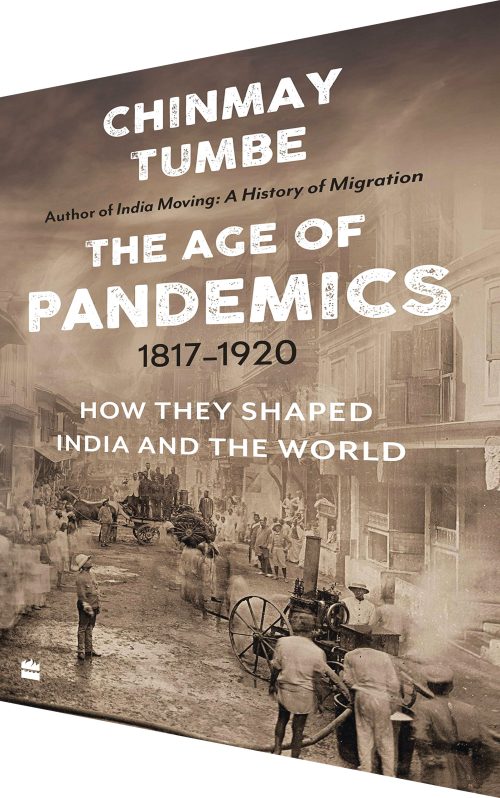No products in the cart.
Egregious oversight: The Age of Pandemics
 The Age of Pandemics 1817-1920: how they shaped india & the world
The Age of Pandemics 1817-1920: how they shaped india & the world
Chinmay Tumbe
HarperCollins
Rs.318; Pages 292
The novel Coronavirus, aka Covid-19 pandemic which originated in neighbouring People’s Republic of China in November 2019, is still spreading contagion and death nationwide — and around the world.
In India, the national response has experienced play out of Murphy’s Law — everything that could have gone wrong has gone wrong.
Only four hours’ notice was given prior to the shutdown of all public transport services nationwide. As a result, an estimated 100 million bottom-of-pyramid rural migrant labour employed in low-end daily wage work in urban habitats were stranded without money and housing, with millions of them obliged to undertake long treks back home to their villages. This was followed by shortages of hospital beds, PPE (personal protection) kits, oxygen and latterly vaccines countrywide.
Yet none of these misadventures should have happened because no geographical region worldwide has as much experience of pandemics as the Indian sub continent. Proof of this verity is provided in this timely and deeply researched history of pandemics authored by Prof. Chinmay Tumbe, who traces killer epidemics that swept the world during the past century and provides convincing proof that the Indian subcontinent was the epicentre of them all. According to Tumbe, who teaches economics at the top-ranked Indian Institute of Management, Ahmedabad, during the period 1817-1920 three overlapping pandemics spread globally — cholera, plague and influenza — claiming 72 million lives. Of that grim toll, 40 million died in India.
Therefore we should have had ingrained experience of responding to — if not efficiently managing — pandemics. But as gross mismanagement and bungling of the Covid-19 pandemic still raging through the subcontinent indicates, all information and knowledge of managing pandemics seems to have been erased from our history books and collective public memory.
Why? This is the question the learned author sets out to answer in this fluent and enlightening history of the great pandemics of the past century.
The cholera and plague pandemics abated by the early years of the 20th century and were replaced by perhaps the even more lethal influenza pandemics for which the watershed year was 1918. History texts covering that era are replete with momentous events of the time. The First World War had just ended, M.K. Gandhi returned to India in 1915 after several decades in South Africa and quickly became the prime leader of the nationalist freedom movement, especially after the Jallianwala Bagh massacre (1919) in which hundreds of peaceful protestors in Punjab were shot down in cold blood by British commanded Indian troops. “However, if there is anything that 1918 should be known for, it is the great influenza pandemic that wiped out 40 million human beings in a matter of months. Based on my estimates, around 20 million of them died in the Indian subcontinent alone,” writes Tumbe.
It’s pertinent to recall that in the period covered by Age of Pandemics (1817-1920) cholera, the plague and influenza killed 72 million people worldwide and 40 million in India. Between 1918-20 when the so-called Spanish-flu pandemic swept India, the country’s population was estimated at 300 million, of whom 15 percent was wiped out. By that measure, it can’t be ruled out that the novel, dangerously mutating Covid-19 virus could kill 80 million citizens of India, i.e, Bharat.
The value of this magnum opus is that it raises the critical question why despite extensive experience of pandemics and huge loss of lives over the past century, they have been brushed under the carpet by historians and intellectuals. This curious collective act of omission is the prime factor behind this country being utterly surprised by the new pandemic. It is a sad reflection of the quality, competence and capability of post-independence India’s academy and establishment that the official response to the Covid-19 pandemic has been so belated, casual, confused and blundering.
Given India’s history of pandemics — 40 million fatalities during the past century — our celebrated economists of the Soviet-style Planning Commission who drew up 12 detailed five-year plans, should have been aware of the dangers of miserly investment — an average 1.4 percent of GDP — in public health and 3.5 percent in education over the past 60 years. Nor did they accord any importance to affordable public housing or civic planning.
The consequence is that 40-50 percent of the residents of India’s 4,000 cities live in squalid slums without basic sanitation and their filth, dirt and disease is contaminating the groundwater reserves of the country. Ditto in rural India which ungraciously hosts 67 percent of the republic’s population where no safe drinking water and public health infrastructure worth the description has been built. Therefore, bearing in mind that cholera is a water-borne disease, a new cholera pandemic could break out anytime.
Nor do any worthies of the establishment whose salaries and perks swallow almost 25 percent of the annual Union budget, seem at all concerned that the rodent population of Mumbai for instance, is two-three multiples of the human population (15 million), raising the omnipresent danger of a new plague pandemic. And the point stressed in this volume backed by historical research and scholarship is that pandemics don’t break out sequentially, they can be simultaneous and often overlap each other.
After the Black Death devastation of the 14th century and influenza pandemic of 1918-20, successive governments of European countries applied themselves and invested massively in public health, education, sanitation and affordable public housing. Unfortunately, these are bottom priorities, if at all, of the professedly socialist governments and meekly compliant establishment that have misruled post-independence India.
The concluding chapter titled ‘Covid-19 in the Rear-view Mirror’ of this book should be mandatory reading for all so that the egregious errors and miscalculations of the current pandemic are not repeated when the inevitable next pandemic is upon us.
















Add comment